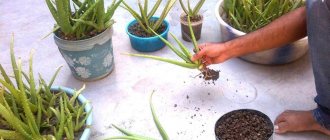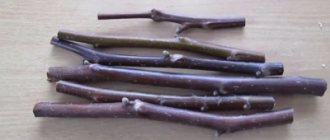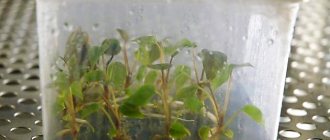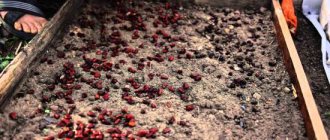You were given a bouquet of beautiful roses, how great it would be to grow the same ones in your dacha. Or you bought planting material of a rare variety of roses, it took root, but you would like to propagate it quickly. What to do?
After all, vegetative propagation of many varieties of roses is not such a simple task, especially in relation to rare varieties and hybrids, when the amount of starting material is limited, and the samples themselves are very sensitive to environmental conditions and growing technology, due to the instability of the line.
Bouquet of roses
This problem can be solved quite simply using the so-called “burrito” cutting method, which originated in the USA, proved its effectiveness, quickly gained popularity and spread throughout the world. He also reached Russia and the CIS countries. However, there is very little literature on this method, especially in Russian. As a result, he is surrounded by a certain aura of mystery. Let's try to figure it out.
What is the essence of the burrito cutting method?
Propagation of roses by cuttings (burrito method).
© gileya Propagation of roses by cuttings (burrito method). © gileya Propagation of roses by cuttings (burrito method). © gileya Callus or callus (from the Latin callus - callus), plant tissue (growth) formed on the surface of wounds as a result of the division of nearby living cells. It is this that promotes the formation of roots during vegetative propagation of plants.
After a few weeks, this “shawarma” stuffed with rose cuttings gives quite viable shoots. That’s actually the whole method, the phrase “everything ingenious is simple” suits this method perfectly, although there are many nuances here too. Let's look at the application of the method step by step.
Caring for planted roses
Planting cuttings in open ground after roots appear is a very important moment. In this case, the soil should be loose, light and breathable. It is necessary to moisten the soil every day without oversaturating it with water. Excessive moisture can lead to rotting of the root system of the flower.
You can add sawdust, coarse sand, vermiculite and perlite to the soil for looseness. Be sure to periodically apply mineral fertilizers:
- Potassium regulates water in tissues and prevents the development of diseases.
- Phosphorus stimulates flowering.
- Magnesium promotes the formation of chlorophyll.
- Calcium accelerates the emergence of the root system.
- Nitrogen affects the growth of leaves and shoots.
Cutting rose cuttings.
Cuttings can be taken in the fall, but it is especially convenient in the spring, when rose bushes are usually pruned. The length of the cuttings is usually up to 20 cm with 3-4 buds. The thickness is very important, at least 0.5 cm, then the nutrients contained in the stem will be enough for the formation of callus and roots. Sometimes thin ones also sprout, but this is rather an exception.
Rose cuttings. © Garden Girl
Choosing the right cutting
It’s good if a neighbor shared with you the results of autumn or spring pruning. Then you have plenty to choose from. And of course, for planting you will take only the strongest, thickest and most beautiful cuttings. It is much more difficult if all the available material is one branch, from which you need to select at least two fragments suitable for planting.
The length of the cuttings is usually up to 20 cm, with 3-4 buds. Thickness and appearance are equally important. A diameter thinner than 0.5 cm is not suitable; the branch simply does not have enough strength and supply of nutrients to form roots. A thin cutting can germinate, but this happens much less often, and it is not a fact that the plant will have enough strength to survive the first planting in the ground.
Packaging of rose cuttings.
Cuttings of 4-7 pieces are wrapped in newspaper (2-3 layers) or paper towels and moistened with water, then wrapped in polyethylene and placed in a dark place at a temperature of 14-18 degrees. This is a very important point. If packages with cuttings are stored at a lower temperature, then the process of plant development is greatly inhibited, the plant seems to be in a dormant period, and at a high temperature, the roots quickly dry out and die (and even if they are constantly moistened, there is a high probability of their molding ). It is this temperature regime (14-18 degrees) that is most favorable for the gradual development of the plant, when roots and callus are formed first. Therefore, usually an apartment is not entirely suitable for these purposes.
Formation of callus and roots on cuttings. © Kim Rupert Callus and root formation on cuttings. © Kim Rupert Callus and root formation on cuttings. © Kim Rupert
Possible problems and difficulties of cuttings
Even if you take cuttings using the burrito method, problems may arise:
- At low temperatures, callus will form, but roots will not develop.
- At high temperatures, the branches often wither or dry out.
- Rots form at high humidity and temperature.
- Cuttings can get sick if they are not treated with special means.
- If the plants die after planting, then the land is not suitable for them.
Thanks to a simple propagation technique you can get a large number of roses
The burrito method is quite simple. If you follow all the rules, you can get a lot of rose bushes without spending a lot of time and effort.
Planting sprouted rose cuttings.
When a full-fledged callus is formed and roots appear, the rose cuttings are planted in jars or pots (one at a time) in the soil so that the upper bud rises above the surface. The pot or jar is covered with film, creating a water bath. The temperature should now be above 23-25 degrees. Spray frequently, gradually opening the film as the cuttings grow.
That's all the technology is. It does not require large expenses and gives very good results; the survival rate of rose cuttings is high and allows the propagation of even the most capricious varieties of roses. However, not only roses...
Planting plants in the ground
As you can see, the method of propagating burrito roses is not at all difficult. The secrets we discovered today can help many summer residents grow their own magnificent rose garden. The final step is to plant the cuttings in a jar or pots one at a time. Make sure that the top bud rises above the surface. The pot is covered with a jar and film, the air temperature at this stage should be no lower than 23-25 degrees. You need to spray frequently, gradually opening the film as the cutting grows.
Step-by-step instruction
- Preparation of inventory . A sharp, clean pruner or knife is required. You will also need newspapers and plastic bags.
- Cutting cuttings .
The length of the cuttings should be about 20 cm, and the thickness should be 4-5 mm, that is, approximately the size of a pencil. They must have at least three dormant buds. They are cut from the middle part of the shoot. Be sure to inspect the cuttings to ensure they have smooth bark without damage. If they have rot or spots, they are not suitable for propagation. All petioles and leaves are removed from the cut cuttings. The thickness of the cut cuttings is very important; you cannot take thinner or shorter than the specified dimensions. They must retain enough nutrients for rooting, otherwise they will simply dry out. - Processing cuttings. If these are autumn cuttings and they have been stored for some time in the refrigerator or on the balcony, you need to update the cut with a sharp knife.
In a plate with filtered water at room temperature, dilute the drug to stimulate root formation in the dosage indicated on the package. Immerse the cuttings to a third of their length and leave for 6 hours. If it is not possible to purchase such a drug, it can be replaced with aloe juice diluted in water in a ratio of 1:9, or with honey (a teaspoon per 0.5 liter of water).After this, treat the cuttings with a fungicidal preparation to eliminate the possibility of fungus formation.
Packing in newspaper and bag . Cuttings are taken in 4-7 pieces and wrapped in newspaper folded in several layers. It must be wrapped completely, the edges should not peek out. Then the newspaper must be wetted with water so that it becomes damp, but does not fall apart. Excess water should drain from the newspaper. After this, the bundle is wrapped in a plastic bag. If you don't have newspapers, you can replace them with paper towels.
- Waiting and checking the result. The bundles with cuttings are stored in a cool place where the air temperature is +14-18°. This temperature regime is most favorable for callus formation. If the apartment is hot, it is better to store the packages somewhere else.
They need to be checked once a week. The newspaper is carefully unfolded and the cuttings are examined. If mold or rot begins to form, the entire package should be thrown away. If necessary, the newspaper must be moistened; it must not be allowed to dry out completely. Every two weeks it is necessary to treat with a fungicide.Callus appears after 2-4 weeks. It will be immediately noticeable, it looks like sagging on the surface of the cuttings, roots will form from them.
- Planting sprouted cuttings . After the appearance of full-fledged callus and the first roots, the cuttings are planted one at a time in small pots or jars. It is better to buy special soil, which is intended for roses. Important! The cuttings need to be planted so that the top bud rises above the surface of the soil, and the rest are in the ground.
The jar or pot should be packed in a bag, creating the effect of a water bath. The temperature in the room must be at least +23° for the cuttings to take root. The package with germinating cuttings must be often opened, ventilated a little, sprayed and watered. You cannot turn the soil into non-drying mud, but complete drying of the soil will lead to the death of the cutting. As the cuttings grow, the bag is opened slightly. - Rooting of seedlings .
Cuttings rooted in pots are planted in open ground in late spring, when night frosts are guaranteed to have ended. Reference. If spring cuttings were propagated using the burrito method, then after the roots appear, they can be immediately planted in open ground and covered with film, setting up a small greenhouse. You need to choose a place that is sunny, sheltered from the wind, and level so that rainwater does not flood the seedlings. You can put some organic fertilizer in the planting holes. Before planting, the stems of the seedlings are cut off, leaving 3-4 buds. After planting, seedlings must be watered and sprinkled with sawdust. It is also advisable to shade them from the scorching sun. After adaptation in the soil, seedling growth will begin in 10-15 days. - Further care of the young plant . After young shoots grow 12-15 cm, you can feed them with a special fertilizer for roses with the frequency and dosage indicated on the package. In the first year, young bushes must take root, so they should not be allowed to bloom, this will take a lot of energy from the plant. If buds appear, they must be cut off immediately. In the fall, you need to provide young rose bushes with reliable shelter for the winter.
How to grow from a bouquet
Murraya muraya growing and care at home
This event provides for certain nuances that every novice gardener should know about before embarking on the implementation of his idea.
- Rooting of cuttings of plants with red or pink buds is most successfully completed. If you try to root stems with yellow and orange flowers, in most cases you will fail. The most risky is the rooting of plants with white and white-green buds;
- To increase the chances of rooting of cuttings, it is advisable to do this in late spring, summer and September. If you choose a different time for this activity, you will expect a lower percentage of rooted cuttings. Serious difficulties await you if you decide to root roses in this way in January-February. Indeed, at this time of year it will be necessary to provide the bushes with additional lighting and maintain an optimal level of air humidity;
- Those who believe that a cutting that began to grow after transplantation already has a formed root system are greatly mistaken. There are many cases where after a couple of weeks the shoots dry out and the cuttings turn black and die. In such situations, it does not even come to the formation of callus - the tissue that is necessary for the formation of roots;
- Most often, rooting of cuttings with weakly blossomed buds ends successfully. By using plants that have long since flowered and have been sitting in a vase for at least a week, you are setting yourself up for failure. Time in the vase directly affects how much strength the plant has left to take root.
Rooting procedure
If you have long had the idea of propagating a bud you like, but you don’t know how to plant a rose from a bouquet, then you should start implementing this idea the moment you put it in a vase.
- First of all, you need to trim the tip of the stem with sharp scissors to create a slanted cut and place it in water. As a result, you will prevent air bubbles from entering the cut area. The rose will benefit if you renew the cut every day and add fresh water to the vase. You can also add a little honey to a vase with a flower: one drop will be enough, and then you will see changes. After all, honey is an excellent biostimulant. The stem should be more than half in water;
- Even before taking cuttings, you will have to cut off the bud. After this, the stems are immersed in a container of water so that they are completely hidden in it. They should remain in this state for 24 hours;
- The middle part of the stem is used to take cuttings. They should not differ in thickness from a pencil, and the length should be 15-25 cm. Be sure to tear off the leaves except for the two located at the top. You don't need the spikes, so you can remove them too;
- For propagation, you can use cuttings that have at least two or three buds. The cut located at the bottom of the stem should be made at an angle and located in the middle between the internodes. The upper cut is made horizontally; it should be no higher than 1 cm above the kidney. Subsequently, it must be treated with a crushed tablet of activated carbon. In the lower part, an incision is made in the form of a cross with a knife, and it should penetrate approximately 8 mm deep.
You can also root cuttings with one bud. But it makes sense to resort to this method in cases where there is a limited number of colors available. In this case, three or four cuttings 8 cm long can be obtained from one stem. However, only those cuttings with a bud in the middle can be used for rooting.
Use of biostimulants
After this, it is necessary to treat the cut at the bottom of the stem using any available root formation stimulants. The choice of such drugs today is quite wide:
- Kornevin;
- Heteroauxin;
- Epin;
- Charkor;
- Aloe juice (20 drops per glass of water);
- A teaspoon of honey per glass of water.
When the cut site is treated with a powder stimulant, the cutting is transferred to the soil. If a liquid biostimulant was chosen, then the cutting must be kept for 12 hours.
The essence of the method
Here, too, everything is not simple, so first we will explain to you where this definition came from. Moreover, this applies to any cuttings, be it an apple tree or a gooseberry, but today we are talking specifically about the propagation of roses. The burrito method was named after the Mexican “shawarma,” a traditional flatbread that wraps beans, cheese, and vegetables. What is the similarity between the propagation of bushes and a culinary product, you ask? But it does exist, and it’s quite straightforward. Instead of filling, in our case, we take a fresh stalk, cut in a special way, and the role of a flat cake is played by moistened newspaper. It is in this way that optimal conditions are ensured under which the cutting quite easily forms a white growth, the so-called callus, in the place of which roots then appear.
If you remember a little about the school botany course, it will become even clearer on what this propagation of roses is based. The burrito method allows you to control temperature and humidity, as well as observe how the cuttings behave. This is not possible if you place them in a pot with soil in the traditional way. So, the callus mentioned above is plant tissue that is formed during cell division. It is this that is the basis for the formation of roots during vegetative propagation.
Packaging of planting material
Let's now move on to practice and look at how to plant a rose from cuttings in the fall. Carefully inspected processed samples must be properly packaged and left to germinate. To do this, you will need regular newspaper or a paper towel. Do not forget that this material dries quickly, so you need to fold the paper in 2-3 layers. It doesn’t make much sense to wrap one at a time, because there will be too many bags to keep track of. The best option is to pack 3-4 pieces together. Propagating roses by cuttings in the fall has a huge advantage. Over the winter, a fairly strong plant will grow on your windowsill, which will easily survive transplanting into the ground.
Application at different times of the year
Cuttings in autumn:
- After autumn pruning of roses, there are many cuttings left that should not be thrown away; they can easily be turned into new bushes using this method.
- It is in autumn that the quality of the cuttings is the best, since they are ripe and have the thickest bark.
- There is a good supply of time, since by spring the cuttings will probably have roots. Over the summer they will take root well, so they will survive the winter well, provided they are properly protected from frost.
- If you apply this method to cuttings taken in early fall, you may need to plant them in pots because they have sent out roots, but it is too early to plant them outdoors.
- If desired, autumn cuttings can not be rooted immediately, but stored in the refrigerator, wrapped in dry paper and a plastic bag with holes. If there are a lot of cuttings, they are put in a cardboard box and stored on the balcony or in the cellar (if they do not freeze in winter).
in winter:
- Late varieties of roses, which bloom all summer and the first half of autumn, are pruned by some gardeners at the end of November, or even at the beginning of winter. These cuttings can be used for propagation using the burrito method.
This is especially true for regions where the winter is warm and there is no snow in early December, or even the entire first month of winter.
- By spring, the cuttings should take root well.
- There is less risk that they will produce such large roots that you will have to plant them in pots at home and replant them in the ground in the spring. Winter cuttings can easily wait until spring, when they are planted in open ground in a permanent place.
in spring:
- Only mature old shoots are taken as cuttings.
- After they send out roots, they are immediately planted in the ground; there is no need to grow them in pots in the house.
Attention! Cuttings that have overwintered may show hidden signs of disease and damage. Therefore, the rejection rate is always higher than with autumn propagation by this method.
When should you choose this method and when not?
The main task is choosing the right planting material. Therefore, this method is not used in the summer, since the rose cuttings have not yet ripened, they have thin bark, they will not withstand a long stay in wet newspaper and will rot.
Gorgeous huge Dutch roses on long stems cannot become planting material . Therefore, do not rush to cut the presented bouquet into cuttings. Such roses are not adapted to our climate. Even if you are lucky and they send out roots, they will not take root in the soil. Find out more about whether you can root a gifted or purchased rose, and how to do it, in another publication.
This method is suitable for propagating roses from your own garden, or you can ask your gardener friends for cuttings. That is, for propagation in an unusual way, burritos are suitable for varieties that are adapted to our climate and tolerate wintering well.
What it is
In fact, you all know very well what it is, even if you are hearing such a term for the first time. The burrito method is the vegetative propagation of a bush, that is, cuttings. True, this does not make it much easier for a novice gardener, especially if you managed to get hold of a rare variety or hybrid. At the same time, the amount of starting material is very limited, and the samples themselves are extremely sensitive to environmental conditions and growing technology.
It is very good if at this moment an experienced florist comes to the rescue, who has already performed a similar procedure more than once and knows how to propagate roses. The burrito method originated in the USA and has proven its highest efficiency, quickly spreading throughout the world. Russia and the CIS also did not stand aside, however, we still have very little professional literature devoted to this problem. Therefore, the mystery of cuttings is passed on from gardener to gardener, and not everyone wants to share the secret they receive. Let us today lift the veil of secrecy and penetrate into its essence.
How to grow a rose from cuttings at home
In terms of efficiency, propagation by cuttings is one of the most popular methods among gardeners. This can be explained by the fact that if done correctly, you will be able to get a bush of the variety that you dreamed of from the very beginning. You can root cuttings from a bouquet either in ordinary soil or in pots or other containers you have at home.
One point needs to be clarified right away: you can find many opinions about this method on the Internet, and not all of them are true.
You need to be prepared for rooting of cuttings to succeed in no more than 70% of cases. The survival rate is even lower for long-stemmed plants, which does not exceed 15-20%. However, if you are determined to obtain planting material in this way, then it will not make much difference for you whether to root one cutting or a dozen.
Wouldn't it be better to put it in water?
There are different ways to propagate roses. Some gardeners suggest using a different scheme, which allows you to observe the condition of the cuttings without unfolding them. The cuttings are placed in cold boiled water and changed every two days. After 15 days, a root embryo should form in the form of a white ball. In this state, you can already plant it in a pot of soil. Some people prefer to wait another week until real roots appear. The disadvantage of this rooting method is that the roots do not have enough oxygen and they may begin to rot. That's why they come up with an alternative. On the one hand, this could be an aeration system, and on the other, placing planting material in suitable soil. Rose cuttings in water readily produce roots, but excessive or insufficient temperature, abundance or lack of light can affect this process. The cutting may begin to produce leaves. In this case, it will lose strength and will not be able to grow the root system.
Basic rules for growing roses from cuttings
In order to get a beautiful and strong plant without much hassle, a propagation method such as cuttings is excellent. Such a plant will not have roots, which will greatly facilitate its care. This propagation method will also save the gardener from many problems associated with purchasing planting material. And that’s all, because plants purchased in a store can also be propagated in this way.
The first thing to do is to prepare the cuttings themselves. For the cutting, you should choose a shoot that has at least 5 leaves; in this case, it will produce roots much better than those cut stems that have only 2 leaves. Also, these cuttings are grafted several times better. The cut must be done very carefully, and it must be oblique. Cut the shoot a few centimeters from the buds
After this, you must carefully tear off all the leaf plates located below from the cuttings. Shoots of medium thickness are excellent for cuttings, but thick or thin stems are not recommended for such purposes.
Experienced gardeners do not recommend propagating imported roses by cuttings; the fact is that such cuttings rarely take root normally. The best plant for this procedure is one that grows in the area where you live.
It is also very important to note that the cuttings must be fresh
The entire cutting process is divided into 4 stages:
- Fill a small container with a weak solution of potassium permanganate. Then the cut cuttings should be placed in it and left there for the whole day.
- Then the cutting is planted at a relatively shallow depth. So, 1 bud should be in the soil, and the second should rise above its surface.
- In order for rooting to be successful, you can make a mini-greenhouse from film, and a cap is also perfect for this purpose.
- The seedling should be provided with the necessary care. It needs to be watered and ventilated on time. After rooting, it is transplanted into a permanent pot.
If you do everything correctly, then after some time the cutting will grow a strong root system, and in just 2 years you will be able to fully enjoy the beauty of the rose that you yourself grew at home. In order for a young plant to grow and develop well, as well as to be strong and healthy, it is necessary to remove all the buds that form in the first 2 years of life. However, you should not feel sorry for them. The fact is that the plant spends too much energy on the formation of buds, as well as on their growth and development.
Burrito method
Delphinium (reproduction)
Almost every Canadian florist knows how to propagate roses using a method that is completely unusual for Europeans.
By using the burrito method in rose propagation, you can get a lot of seedlings. High-quality material is selected after autumn pruning, and it is taken in sufficient quantities from neighbors in the country, in parks. You need to choose any garden or park bush variety with a powerful thick stem.
Burrito method
From the trimmings of rose bushes, the strongest stems are sorted and cleaned of petioles and leaves. For cuttings, branches with the largest number of buds are selected and a cut is made under the lowest one. Having measured a length of about 20 cm, cut off the top.
Each specimen is carefully examined for infection and disease. If there is any suspicious damage, the branch is rejected.
Let's make a burrito
Before you grow roses using the burrito method, you should stock up on newspapers.
One newspaper is required for each prepared cutting. The stem is wrapped in a tube and moistened in water. The newspaper should get wet, but not spread; excess water should drain off.
All moistened burritos are placed in plastic bags in quantities of approximately 20-25 pieces and placed in a place with the most constant temperature, approaching +18ºС.
Burrito method, what you need newspaper for
In this state, the cuttings can be preserved until spring, when they can be planted.
The burritos are inspected weekly, moldy or rotting cuttings are removed, and newspapers are replaced or moistened if necessary. Soon, healthy branches will be covered with an influx of callus at the cut sites and root formation will begin.
Rooting roses using the burrito method can be done year-round. Seedlings provided with warmth and light grow well in winter.
How to plant a rose from cuttings
Buying rose seedlings is sometimes quite expensive, because a rose variety purchased in a store or market may simply not take root or may not even be the variety that you wanted to plant in your garden. For these reasons, many people breed roses by cuttings from a bouquet they like or by asking their neighbors in the country for one rose to plant in their home. If you meet all the conditions and use all the useful tips when cutting, your rose will quickly grow and will delight you and those around you for many years.
So, how to properly plant a rose cutting, method No. 2. In a large potato tuber, having first removed all the eyes from it, stick a rose cutting and bury it in the ground so that the second tip of the cutting is above the ground. Then water it and cover it with a glass jar (you’ll get a kind of mini-greenhouse). In this way, the cuttings will receive all the nutrients they need from the tuber. Just remember that the cuttings need to be watered regularly.
For rose cuttings, it is better to use the lower or middle part of the shoot, 5-6 mm thick. There should be 2-3 buds on the cuttings. The upper cut of the cutting should be made at a right angle at a distance of 0.5-1 cm above the bud, but the lower edge should be cut at an acute angle and located 2-3 cm below the bud. Cuttings of cuttings should be made with a sharp knife in order to prevent the formation of rot on the torn edges. Shorten the leaves as much as possible before cutting; the bottom leaf and thorns must be completely removed.
Method of growing a rose from a cutting No. 3: you should take a rose twig with 7 nodes (so that there must be 7 mouths, that is, branches between the stem and the leaf) and thus plant the cutting in the ground, covering them for the first time with a jar (an ordinary three-liter glass jar) . Cut the stem on the planting side at a sharp angle with a knife so that the cuttings take root better (better to take water from the ground).
Method of growing a rose from cuttings No. 4: you need to take a rose twig and cut off the shoot on both sides at a sharp angle with a knife in the place where the buds with the future twig will be or have already formed between the leaf and the stem. Then plant the cuttings in watered soil as close to the ground as possible with the buds, water the ground and be sure to cover the seedling with a jar. This method is probably the simplest. By the way, it has been personally tested and this method of planting roses from cuttings works.
The photo below shows a rose seedling from a cutting on the 7th day after planting by cutting.
Useful tips for cutting roses
A few proven useful tips, one might say, the secrets of cuttings:
- It is recommended to root no more than three cuttings in one container.
- When water evaporates, it is better to add a little more than to replace it completely with a new one.
- There should not be too much water in the container with cuttings (so that they do not rot from lack of oxygen).
- In order for the root system to develop better, it should be rooted in an opaque container.
- The lower to the ground the piece of stem for the cutting is, the better and faster it will take root.
- If there are no leaves on the cuttings, roots can form in the dark, but if there is at least one leaf on the cutting, light is needed for its rooting.
- Cuttings from young side branches of plants take root better.
- Roses grow better with the appropriate fertilizers, so keep this in mind.
- Roses are light-loving, heat-loving, do not like wet soils and prefer neutral ones.
- Roses, especially rose sprouts, do not like white walls, strong winds (drafts) and, as it turned out, direct sunlight at the very beginning of cuttings. When the first leaves appeared (about 2 weeks after cuttings), they removed the jar in the morning and after 3 hours they found wilted and curled fallen leaves. The jar was returned to its place, after watering the rose, and by the evening it had already come to life.
Good luck!
Propagation of roses at home
Cuttings of bouquets are only possible from roses growing in their homeland, since imported specimens are treated with preservatives that do not allow the propagation of roses.
Before growing roses at home, you should make sure that the bouquet is fresh enough. For a high-quality cutting, the stem should be slightly woody, of medium thickness, and have buds at the bottom and top.
Note! Imported roses with long stems do not take root well in a flower garden.
The highest quality cuttings will come from the freshest bouquet and will have to be sacrificed. Remove flowers, thorns, buds. All lower leaves are cut off, and the upper ones are shortened by 2/3. The cuttings are placed in distilled water and changed daily until roots appear.
The finished seedling is transplanted into the ground, covered with a jar, or into a pot.
Summer breeding
Summer propagation is the most natural way. Cutting the stems is carried out early in the morning or in the evening. Stems are selected that are mature, whose thorns are easy to break; before flowering or immediately after it.
A sharp sterile knife is used for cutting. A pair of leaves and buds are left on the cuttings. Planting material is kept in Kornevin, Heteroauxin.
A pair of leaves and buds
Many flower growers use their own reliable method instead of stimulants: cut several leaves of the same variety into a glass of water and add a spoonful of honey.
Such propagation can be carried out all summer.
Open ground cuttings
Before you propagate roses directly in the garden bed, you should prepare the correct substrate. Its composition should include coarse-grained washed river sand and fertile soil.
The prepared holes are watered with a steep solution of potassium permanganate and added dropwise at an angle, deepening the lower bud. The seedlings, pre-watered, are covered with jars.
Important! It is more difficult to cut park and remontant flowers.
The most suitable month for this operation is July, since it has an optimal temperature. The planting material takes a month to take root. During this time, the seedlings are hardened, and when August comes, the jars are removed completely. The emerging buds are pinched so that the root system develops better.
Chinese rose
The flower of this plant is very reminiscent of small gramophones in pink, burgundy or red. These are traditional colors, but in recent years, thanks to breeders, orange, yellow and even multi-colored buds have appeared. This is a durable plant that can delight its owners with flowering for 20 years. How to propagate this type of rose is discussed in the article below. And now a few words about the conditions of detention. This flower needs space; the ideal option is rooms with high ceilings, since its height can exceed 2 meters.
It is noteworthy that the plant has nothing in common with Rosaceae, nevertheless it is called a rose. Flower growers love this species because of its unpretentiousness. Although the flower grows to gigantic sizes, it does not require frequent replanting. You just need to water it on time and fertilize it periodically. To give the crown a beautiful shape, you need to trim the branches.
How to make a seedling from a rose
Raspberry propagation
The time when you manage to get a unique rose is usually in the fall. And the question immediately arises of how to breed such roses, how to grow seedlings from the resulting specimen.
After waiting until the bouquet has almost completely withered, select stems with three or more buds in the middle part. After cutting the cuttings, place them in the stimulant solution overnight.
Rose cuttings
The branches are planted in a container at an angle, the soil is lightly compacted, and watered well. 2 twigs are stuck into the sides of the pot, and a plastic bag is put on top. Supported by rods, it does not fall, and a microclimate is created inside that is favorable for the plant.
Soon the rose will take root and you will have a good seedling by spring.
Growing seedlings on potatoes
Not many people have heard about how to propagate roses on potatoes, but only a few have tried this method.
Such cultivation allows the crop to be planted directly in open ground, without prior formation of roots.
In the spring, a trench is made and a third is filled with river sand. Each selected branch is cleared of thorns and leaves. Medium-sized potatoes are selected and their eyes are removed. A cutting is stuck into each tuber and dug in 2/3 of the way. The seedlings are covered with bottles on top.
Growing seedlings on potatoes
Potatoes will provide constant moisture, starch, and carbohydrates. It will be necessary to feed the seedlings with sweet water every 5 days. After a couple of weeks, hardening begins, and then the bottles are removed altogether.
Soil for rooting cuttings
Any loose, fertile soil that allows air and moisture to pass through is suitable for cuttings This can be garden soil with the addition of peat and sand. As well as ready-made soil mixtures: for flowering plants, for vegetable seedlings or specially made for roses. I used “Krepysh” primer from Fusco. It is ideal for growing rose cuttings because it:
- loose;
- prepared on the basis of peat;
- contains a full range of nutrients (macro and microelements);
- has a pH of 6-7 units - corresponds to the range of slightly acidic and neutral reactions, which is very good for roses.
Advantages of the Burrito method for propagating roses
Professionals in rose breeding prefer to use green cuttings, layering and grafting when propagating. These are proven methods that have shown good results in practice. But I am increasingly resorting to the Burrito method, invented by American merchants who specialize in propagating roses for the purpose of mass sale.
Rooting roses using the Burrito method can be done at any time of the year except summer
The name of the technique was borrowed from the Mexicans. A burrito is a traditional dish consisting of a soft flatbread with various fillings. When using the cutting method of the same name, the cake is “replaced” by paper, and the cuttings are wrapped in moistened newspaper for rooting.
Advantage of the technique:
- high percentage of rooting even when working with capricious varieties;
- possibility of visual growth control;
- seasonal independence (I often use the Burrito method before the growing season);
- ability to control aeration and moisture.
In summer, it is not recommended to propagate roses using this method. Thin cuttings cannot withstand prolonged exposure to newspaper and, as a rule, rot.
How to propagate a climbing rose
With the help of climbing roses you can create unique landscape landscapes
When purchasing expensive varieties of climbing roses to create flower arrangements, you do not have to overpay by buying several plants of the same variety. There are several methods that you can use yourself and get several young plants that have all the characteristics of a mother bush.
Climbing shrub propagation methods
The most popular and effective methods of growing roses are:
- cuttings;
- growing cuttings;
- propagation by root suckers.
Professional plant breeders obtain new plants by growing them from seeds. This is a very long and labor-intensive job that requires patience and special skills. Amateur flower growers use simpler methods
Each method has its own characteristics that you should pay attention to
Additional Information. When grown in warm climates and properly cared for, the length of shoots of some varieties can reach 15-17 meters.
How to root a rose shoot
Propagation of phlox by cuttings in summer
The procedure for rooting a rose is not complicated, especially if you use the step-by-step method:
- Only fresh material is suitable; it is advisable to plant the same day the bouquet is purchased.
- Flowers are selected without the slightest sign of wilting.
- Of these, attention is paid to specimens with the thickest stems, and so that there are more than three buds.
- Under the lowest stem, the stem is cut at an angle.
- A couple of centimeters are retreated from the top and also cut off.
- The bottom cut is cut with a cross and split slightly.
- The cuttings are kept in a honey solution for 10 hours.
- Plant in a pot at a slight slope, leaving one upper bud above the ground.
- Next, watering is carried out and the seedling is covered with a bottle.
Important! You should not work with a lignified shoot - it takes a long time to take root, and roots form slowly.
Flower growers with extensive experience often share their experience on how to root a rose shoot, even if it is stunted. Their secret lies in the use of a special life-giving solution, which is an excellent stimulator for the roots. After its use, the percentage of rooting of cuttings increases significantly.
The recipe includes aloe, sedum, ash and melt water. The seedling stays in the solution for 10 hours, depending on the condition: the weaker it is, the more time it takes.
You can learn from flower growers how to plant rose cuttings correctly.
Grow a rose from a cutting
How to plant a rose cutting, method No. 1.
- First you need to take roses where young shoots or roots have already formed. Then we remove all leaves, flowers and buds from such roses.
- We cut off a 10-15 cm cutting (stem) with already sprouted shoots or roots and lower the cut cuttings into water.
- It is advisable to immediately treat the cuttings with a growth stimulating hormone (they will tell you the right one in a specialized store).
- We plant the cuttings in pots at an angle so that future shoots with leaves are above ground level.
- We insert wooden sticks into the pot, making something like a support for a small greenhouse. You can use, for example, Chinese sushi chopsticks or unnecessary broken pens, pencils, etc.
- We stretch a plastic bag over these supports. As a result, we need to get a mini-greenhouse for roses.
- After just a month, you can check whether the roses have taken root. To do this, simply pull the stem up slightly. If you feel resistance and the stems are not easily removed from the soil, then the root system of the roses is developing.
Burrito is an effective way to take rose cuttings
Cuttings of roses in newspaper using a method called the Spanish word “donkey” or “donkey” will produce roots very quickly. To be more precise, a burrito is the name of a famous dish from Mexico in the form of a wheat tortilla in which various types of fillings are wrapped (meat, cheese, vegetables, legumes). In other words, it is nothing more than “Mexican shawarma.”
By analogy with the technology for preparing such a dish, the essence of propagating cuttings is that they are wrapped in wet newspaper (instead of a cake), inside which active processes of root growth begin. First, callus is formed, and then the long-awaited roots appear.
What a callus or callus is is known to any experienced plant grower. This is a special type of plant tissue, similar to a callus. Callus is formed at the root system of the plant where it is damaged, further promoting its root formation - while creating favorable conditions for propagation by vegetative means.
After a few weeks, the plant “shawarma” stuffed with rose cuttings will produce shoots that will turn out to be quite viable. They can be safely planted in open ground, cared for and enjoyed their further growth in the form of full-fledged seedlings of your favorite shrub.
Cuttings
Cuttings for future roses can also be done in the autumn - just when carrying out traditional pruning before sheltering for the winter. It is no less convenient to propagate roses by cuttings in the spring. In spring, the bushes are pruned to 20 cm in length, and the thickness of the stems is quite enough for the nutrients they contain to best contribute to the formation of callus and the root system. The cuttings should have three to four buds, and their optimal thickness is half a centimeter.
Preparation of cuttings
For cuttings using the burrito method, you can also use your favorite rose stems from a bouquet, but they must be thick and healthy. As an optimal option, it is best to ask a familiar rose grower for good branches that are left after pruning. In order for roots to form as quickly as possible, future seedlings need to be well prepared: stimulate root growth, securely and correctly pack the cuttings in newspaper, carefully monitor the process, and then promptly place new seedlings in open ground conditions.
Rooting prepared summer cuttings in the ground
It is easier to root summer cuttings in the ground because they have enough time to gain strength and prepare for winter. The immunity of such flowers is higher, and accordingly, their survival rate increases.
"Trannoy" method
The main idea of this method is to allow the stem to receive the maximum supply of nutrition from the leaves before pruning. To do this, the stems are cut off at the end of flowering, flowers and dried leaves are removed.
After the buds begin to swell, the stem begins to become woody. Once this process has begun, they must be immediately planted in the soil until the leaves appear. The stems are cut into cuttings and planted several in one hole.
So the gardener hopes to root at least 1 cutting from the group. From above, future seedlings are covered with plastic bottles, periodically watered, weeded and ventilated.
Rose cuttings planted using the Trannois method
Burrito method
Despite the fact that growing roses using this method is practiced, few people can call it effective. It is more suitable for those who like to experiment.
The stems are cut into cuttings, the lower part of which is soaked in a root growth stimulator. The blanks are wrapped in damp newspaper and placed in a dark, cool place, for example, in a cellar.
Theoretically, after 2 weeks, roots will appear on future roses. Due to the material in which the cuttings are germinated, this method received a more common name - cutting roses in newspaper.
Important! The newspaper can be replaced with a thin material of similar structure. The main thing is that it is thin and breathable
Many, for example, wrap cuttings in corrugated paper.
Natural growth stimulator - recipe
For reliable rooting in the future and the fastest possible appearance of roots, various growth stimulants are used. Chemicals are often used that can be purchased in specialized stores, but it is best to prepare a natural remedy yourself. To do this, take one-year-old shoots of young willow (yellow or green), finely chop them and pour boiling water over them. Leave for two hours, then cool and place the seedlings in the infusion for several hours.
Packing cuttings
Next, the cuttings are properly packed in newspaper. They are wrapped together from four to seven pieces, using at least two to three layers of fresh newspaper. Instead of newspapers, you can use soft paper towels.
After this, the future seedlings are wrapped in polyethylene, and the “shawarma” is placed for storage in a dark and warm place. The storage temperature should not be lower than 14-18 degrees, otherwise the formation of the root system will occur very slowly, or it will not appear at all. Too high a temperature should also not be allowed to avoid drying out of the plants.
Packet monitoring
The burrito method involves careful control of the root formation process, so after three weeks you should definitely remove the material from the storage location, check the humidity and see if callus has begun to appear and if the roots have sprouted.
After the first control, the bushes can be additionally wetted (but not too much), wrapped back and kept in storage until the callus and roots grow fully. It is this kind of cultivation that makes it possible to obtain full-fledged seedlings - provided that all the subtleties of simple technology are followed.
Preparing cuttings for propagation
The vegetative method of growing these flowers is the most effective and popular. Cuttings for propagation are:
- Lignified, in other words, last year's.
- Green, that is, semi-lignified, harvested this year. Moreover, they have a greater chance of rooting.
Before propagating roses from cuttings, you need to choose flowers suitable for this. Only plants with living leaves and a strong stem are suitable for cuttings. It is advisable to harvest the material early in the morning, since at this time there is a lot of water in the flower tissues. Cuttings no longer than 12-14 cm are cut from the middle part of the shoot. The thickness of the stem should be at least 0.5 mm. There should be 2-3 buds left on each cut element.
Propagation material should be cut at an angle of 45°. For such purposes, it is recommended to use a sharp and sterile knife or pruning shears, otherwise you can severely crush the flower tissue, which will lead to rotting of the cutting. The lower external organs of the plant and all the thorns are removed, leaving only a few upper leaves for photosynthesis. After this, the prepared parts of the rose for cuttings must be soaked for a day in a solution of a growth stimulator.
Dropping roses
Everyone knows how roses are propagated by layering, since this method is often practiced for berry growers.
It should be immediately noted that growing roses using this method does not produce many seedlings, just a couple of seedlings. The procedure is carried out in June and works with flexible stems.
To properly bury roses, you need to get wooden pins. They hold the flexible branches inclined to the ground. A suitable bud is found on the stem, tilting it, and determining where to prepare the soil. A small incision is made near the kidney and moistened with a stimulant solution.
Dropping roses
Having pinned the branch to the ground, the area with the incision is sprinkled with soil. All the time you need to keep the rooting site loose and moist, and nature itself will take care that the formation of roots is successful.
Important! The grafting site should be well instilled. This will allow the seedling to take root and not feed on the juices of the rootstock.
This method of reproduction for roses is considered the most natural.
Reproduction of roses by layering, or how to propagate Westerland roses
I want to tell you why propagating roses in the fall by spreading and rooting shoots is quite possible. After all, propagation of roses by layering is most often used in the spring, before the buds appear. But one autumn I was preparing roses for winter and decided to try it, come what may. After all, the vines are long, good, and thick, which means they have accumulated enough nutrients, that is, this is the growth of the current year.
I propagated the Westerland rose variety. This is truly a gorgeous rose, with long lashes, such a tall, wide shrub. Both in height and in diameter it reached one and a half meters. It was a shame to trim the shoots. Our winter is quite frosty, sometimes reaching -30 degrees, so we have to trim the roses, spud them, and wrap them in covering material.
Propagation of roses by layering is a fairly simple procedure, so to speak, for the lazy. And most roses are propagated in this way, that is, most retain the variety.
I propagate roses by layering in early October, so that callus and even roots have time to form on the shoots a month before the approximate onset of frost.
So, as expected, I dig small trenches 10 - 15 cm deep near the main rose bush and lay the rose shoot from the bush on the ground so that its middle enters the trench. I make ticks out of wire, which I stick into the ground, pressing the shoot better to the ground so that there is a touch.
In advance, from the middle of the shoot, I tear off the leaves and petioles. It is from these nodes that the roots will appear.
Near the main rose bush, you need to dig small trenches 10 - 15 cm deep and lay the rose shoot from the bush on the ground so that its middle enters the trench. Ticks are made from wire, which are stuck into the ground, pressing the shoot better to the ground so that there is a touch.
Leaves and petioles are torn off in advance from the middle of the shoot. It is from these nodes that the roots will appear.
I fill the top of the trench with shoots with nutritious soil. This can be a mixture of turf soil with compost or peat. Some trenches were covered with ordinary earth, which lay next to the dug trench. Such shoots also took root.
I did not level the tips of the rooted shoots, which reached about 25 - 30 cm, and did not tie them to a support so that they grew evenly. While they are young, they can be shaped. Therefore, they also lay horizontally on the ground.
When the time of constant frost comes, I generously covered the already filled trench and the tips of the shoots (our future roses) with dry leaves, and to prevent the foliage from caking, I first put down unnecessary branches from the garden, which were cut from the trees to form a crown. Thus, branches and dry leaves create an air layer that will prevent the rooted shoots from freezing. On top I put a row of rags, which were used for gardening needs.
In the spring, when the snow melted and there were no severe frosts, I opened the covering structure. The tips of the shoots pleased us with their young, slowly awakening buds - that means they are alive! And this summer they bloomed! All summer they grew like this, near the mother bush, continued to develop their own roots, and if they did not have enough strength, they fed on the juices of the mother bush.
In the fall, I decided to replant the young roses. For this I needed a sharp, “disinfected” shovel. I wiped its blade with cologne. First you need to dig a little trench and see where the bunch of roots is, so that you can trim it later without damaging the roots. You can disconnect the rooted shoot with pruning shears, but for me one sharp movement of the shovel was enough - and the shoot became a separate plant.
Don’t be afraid to try propagating roses by layering in the fall! Because that's when you have a chance to grow more roses than in the spring. Do you know why? Because in the fall you have well-developed shoots, and in the spring they usually freeze, and I would like to save the mother rose bush, not to mention taking away the shoots as well! Good luck to you!
Rules for planting and care
I plant cuttings traditionally - one bud above the ground, the rest I dig in. I make a mini greenhouse on top using a regular plastic bottle, cut into two parts. My plants are in this state until the beginning of summer.
It is important not to forget that roses need regular watering. In extreme heat, I try to shade the plantings to eliminate the influence of active sunlight
When the first leaves appear, I begin to accustom the plants to fresh air. I remove artificial greenhouses for 1-2 hours, gradually increasing the ventilation time.
If you want to create a magnificent rose garden on your site without buying expensive seedlings, it makes sense to try the Burrito method. Using my tips for preparing and rooting rose cuttings, you will definitely get good results.
Irina Ignatievna, gardener











